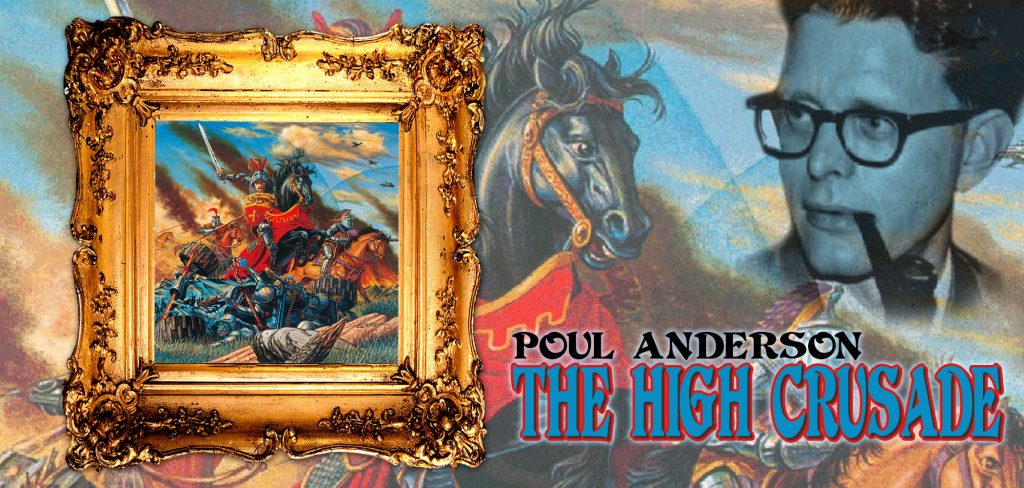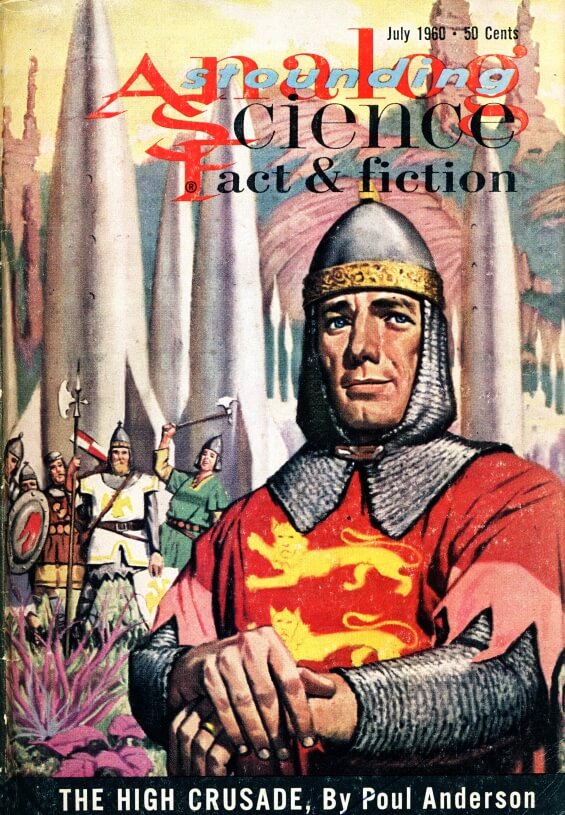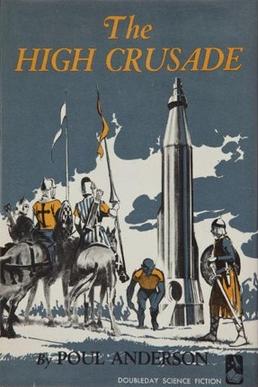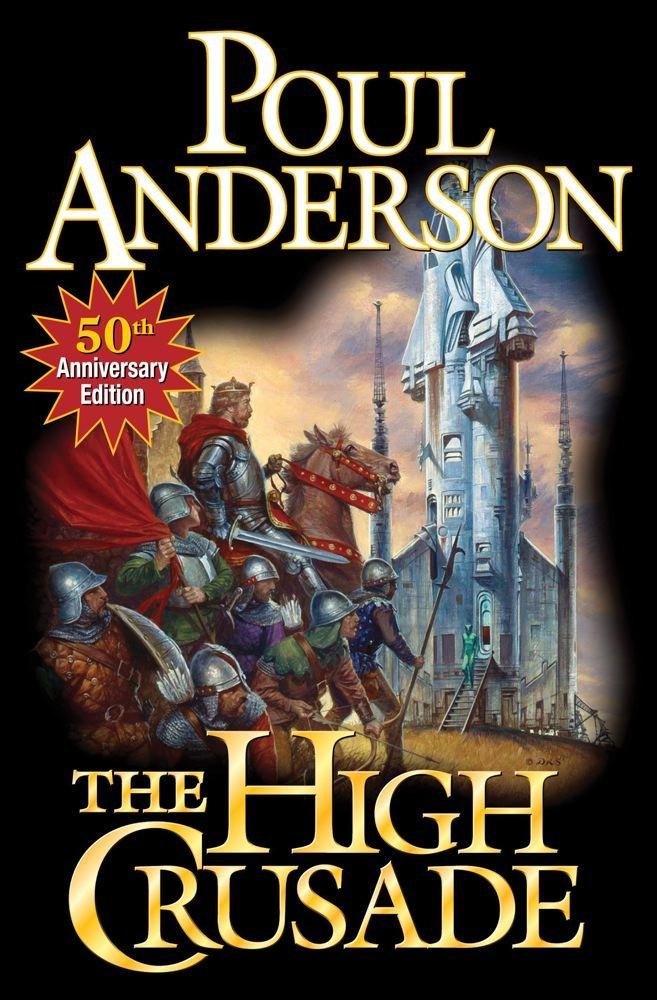Poul Anderson’s The High Crusade
by Bill Ward
“At the moment, all was triumph. Red-splashed, panting, in scorched and dinted armor, Sir Roger de Tourneville rode a weary horse back to the main fortress. After him came the lancers, archers, yeomen — ragged, battered, shoulders slumped with exhaustion. But the Te Deum was on their lips, rising beneath the strange constellations that twinkled forth, and their banners flew bravely against the sky.
It was wonderful to be an Englishman.”
The year is 1345; the place is the village of Ansby, Lincolnshire, England, Earth. A great host is being assembled under Sir Roger, Baron de Tourneville, in preparation for a campaign in France as part of the ongoing conflict that would come to be known as the Hundred Years War. The army features knights and men-at-arms and longbowmen and the various other components of a Medieval host…but it certainly doesn’t have anything to match the likes of the Wersgorix. Alien invaders, the Wersgorix fall from the sky in the midst of Ansby in an enormous chrome ship bristling with weapons. They have anti-gravity, beam cannons, force screens, flame guns, sophisticated communications and mapping technologies and the will to use them — for the Wersgorix are the overlords of an enormous galactic empire that makes a habit of finding new worlds, exterminating or enslaving their populations, and installing new Wersgor masters in their place. The Wersgorix emerge from their ship, demonstrate their overwhelming technological power, and deliver an ultimatum of submission to the assembled primitives of Earth: represented in this case by the arrayed army of Sir Roger.
But, unimpressed, Sir Roger orders a charge, and the ‘assembled primitives’ butcher the shocked crew of the Wersgor scout ship and capture it for themselves.
Thus begins The High Crusade. Slim, fast-paced, fun and compelling in equal amounts, it’s the kind of book people used to write before every idea had to be milked for 500 pages and a sequel. And make no mistake, the premise of The High Crusade is very milk-able, being both instantly understandable and wide-open for exploration. But Anderson keeps his story tight, throwing off clever extrapolations of his ‘Middle Ages meets Space Opera’ idea like sparks off a grinding wheel, all while keeping his story moving at a breakneck pace along the edge of its well-honed plot. Originally written for John W. Campbell’s Astounding, the story bears all the hallmarks of the best magazine fiction of the era, and more’s the pity that such skills are in scant supply in contemporary fiction.
And it’s also a shame that no one can deliver a couched lance charge from horseback like they could in the fourteenth century, either, because such skills just might save us from alien invasion one day. Sir Roger and his victorious army soon decide to make the best of the ‘demonic’ vessel that has fallen into their hands and, with the aid of a Wersgor prisoner named Branithar, they pack the entire village along with the army into the ship and decide to go to France and win the war — but only as their first stop on the way to liberating the Holy Land with their fabulous new weapon. But it is a very different Crusade that they eventually undertake, as Branithar sets the ship’s autopilot for the nearest Wersgor colony where, doubtless, Sir Roger and his fellows will learn what a fluke their success against the Wersgorix really was.
Only, of course, Sir Roger’s army takes that place over, too, and keeps on going. Anderson progressively increases the stakes of the conflict over the course of The High Crusade, and never fails to deliver a solution both novel and logical at every turn. The Wersgorix weaknesses go beyond their having forgotten how to fight in close quarters, and the humans find they cannot rely purely on the tried-and-true methods with which they won their initial success. Here is the heart of the book, the ingenious ways these men of the Middle Ages adapt what they know to fighting an enemy superior to them in nearly every category. So we get to read about delightful juxtapositions such as a trebuchet — its all-wooden construction undetectable by Wersgor scanners — flinging nuclear shells, or volleys of arrows bringing down thin-skinned aircraft protected only by anti-beam forcefields, or knights in spacesuits boarding enemy vessels with axe and sword and longbowmen loosing their shafts within the vacuum of space.
But perhaps the best weapon the humans have is, as Sir Roger terms it, ‘knavery.’ Reared in the complicated and cut-throat politics of Medieval Europe, negotiations among the Wersgor and their neighbors seem like child’s play. Sir Roger out-foxes, out-bluffs, and out-maneuvers the Wersgor at every turn, and the aliens cannot fathom if the humans are some sort of hyper-advanced race that have come out of nowhere, or mad barbarians from the fringe of their empire. The trouble the Wersgor have deciphering human activity — is Sir Roger’s insistence of only speaking with someone suitably ‘well-born’ an indication that his people practice sophisticated genetic engineering? And is the ritual chanting the humans begin their negotiations with, something called the ‘Lord’s Prayer,’ really some sort of psycho-somatic neural trigger that increases their brain functions?
The High Crusade, as should be obvious by now, is a light, humorous book, but it isn’t just about a punch line. Anderson does an excellent job of capturing a Medieval mindset and manages to be both respectful and playful in doing so. The voice of Brother Parvus, the book’s narrator, is also well done, being sufficiently evocative of the norms of Medieval expression to suggest a kind of authenticity while remaining pulpishly readable. It all adds up to an irresistible combination of against-the-odds adventure and culture-clash hilarity that makes The High Crusade one of the undoubted classics of pulp science fiction.








